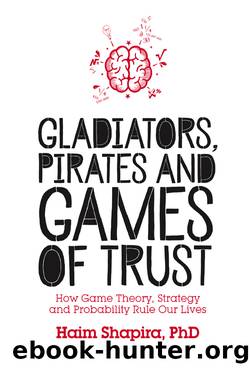1786780100 (N) by Haim Shapira

Author:Haim Shapira [Shapira, Haim]
Language: eng
Format: epub
Tags: Gladiators, Pirates and Games of Trust
ISBN: 9781786780102
Publisher: Watkins Media
Published: 2016-12-17T22:00:00+00:00
Chapter 7
PENGUIN MATHEMATICS
This chapter is devoted to animals â experts in playing games and stars of a field called Evolutionary Game Theory. Weâll discuss the seemingly strange behaviour of the Thomsonâs gazelle as related to altruism, join a gang of penguins in their search for a volunteer, and learn about a nice definition from Evolutionary Game Theory that expands the Nash Equilibrium.
One of the Game Theory branches that I find most fascinating is known as Evolutionary Game Theory, which attempts to study and understand animal behaviour.
I was attracted to this field of study because, among other things, animals tend to be almost completely rational. Now, rationality is the very thing that encourages mathematicians to produce models that attempt to predict behaviours. And itâs nice to see how such models fit with natural phenomena.
One of the fascinating issues I addressed when I first started studying the application of Games Theory to animal behaviour was altruism.
In The Selfish Gene (1976) Richard Dawkins offers this definition: âAn entity ⦠is said to be altruistic if it behaves in such a way as to increase another such entityâs welfare at the expense of its own.â That is, an act is considered altruistic when its results lower the altruistâs chances of survival. Dawkins is in effect trying to offer possible explanations of altruism, because the phenomenon seems to conflict with his own fundamental concept of the âselfish geneâ. He argues that living organisms are mere survival machines for genes that want to move on to the next generation in a competitive world where egocentricity is advantageous. After all, if the living organismsâ only interest was to send their genes forward in time (we could say that self-replication is the only thing that genes care about), altruism should not have survived evolution and natural selection. Nevertheless, nature provides us with many examples of altruistic behaviour, such as the lioness that fights to protect its cubs. Dawkins spoke of a Thomsonâs gazelle that leaps up and down (âstotsâ) instead of running for dear life when a predator comes knocking: âThis vigorous and conspicuous leaping in front of a predator is analogous to bird alarm calls, in that it seems to warn companions of danger while apparently calling the predatorâs attention to the stotter himself.â The gazelleâs behaviour could be viewed as self-sacrificing, or extremely risky; its only motivation is a wish to warn the pack. These are only two examples. Nature provides us with many more, from bees to monkeys.
As noted, at first glance altruism seems to contradict Dawkinsâs selfish-gene theory, but in reality thereâs no contradiction, since thereâs no true altruism in the wild.
The lioness that fights for her cubs may be altruistic on the individual level, but genetically speaking her action is extremely egotistical â the creature is trying not so much to save its cubs as to protect its genes (or, rather, their carriers).
Download
This site does not store any files on its server. We only index and link to content provided by other sites. Please contact the content providers to delete copyright contents if any and email us, we'll remove relevant links or contents immediately.
| Africa | Americas |
| Arctic & Antarctica | Asia |
| Australia & Oceania | Europe |
| Middle East | Russia |
| United States | World |
| Ancient Civilizations | Military |
| Historical Study & Educational Resources |
The Battle of Mogadishu by Matt Eversmann & Dan Schilling(682)
The Confidence Men by Margalit Fox(612)
The Spymaster of Baghdad by Margaret Coker(583)
A History of the Muslim World since 1260: The Making of a Global Community by Vernon O. Egger(575)
Jack the Ripper and the East End by Peter Ackroyd(543)
The Crimean War by Winfried Baumgart(527)
The Afghanistan File by Prince Turki AlFaisal Al Saud(526)
Empire of Fear: Inside the Islamic State by Andrew Hosken(524)
The Jerusalem Diamond by Noah Gordon(513)
Akhenaten by Dominic Montserrat(511)
Islam At The Gates: How Christendom Defeated the Ottoman Turks by Diane Moczar(509)
The History of Jihad by Robert Spencer(500)
A Concise History of Greece (Cambridge Concise Histories) by Richard Clogg(499)
Israel: Ancient Kingdom or Late Invention? by Daniel I. Block(490)
Enemy in the East by Rolf-Dieter Müller(488)
The Privatization of Israeli Security by Shir Hever(477)
Beirut 2020 by Charif Majdalani(477)
Destroying a Nation: The Civil War in Syria by Nikolaos van Dam(476)
The Nine Lives of Pakistan by Declan WALSH(469)
